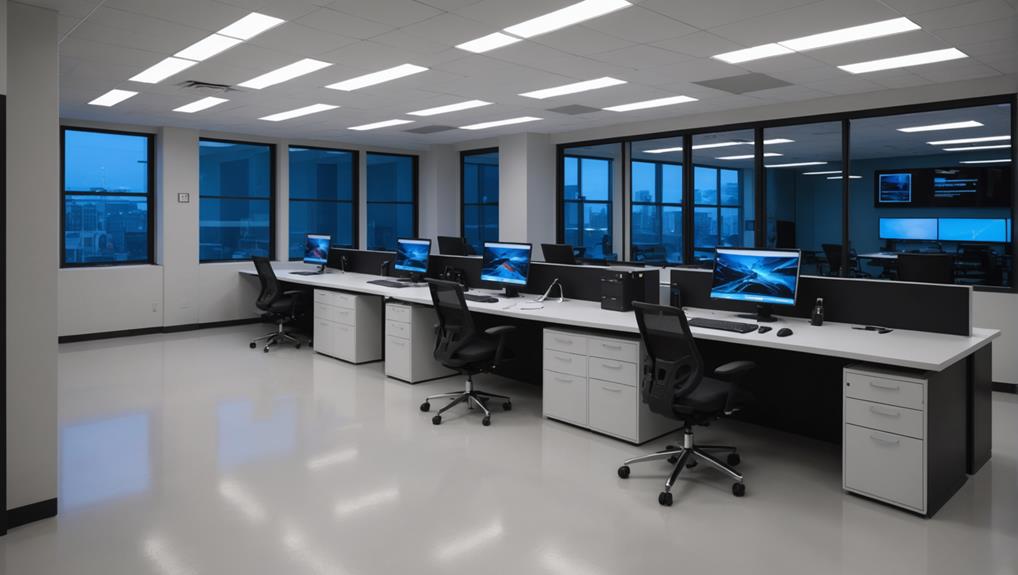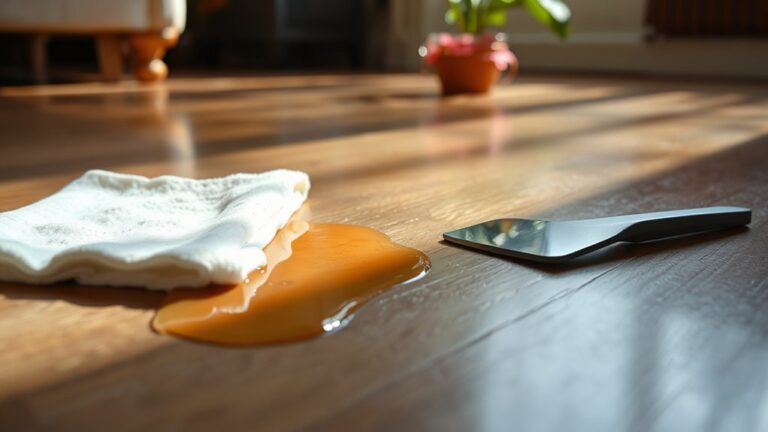Anti-static floors are essential in office technology rooms to protect sensitive electronics from static electricity damage. Traditional flooring can generate static charges, but anti-static options like vinyl, raised access floors, carpet tiles, and epoxy coatings effectively dissipate these charges. They enhance safety by reducing static-related accidents and improving traction and durability. Proper installation requires careful subfloor preparation, humidity control, and grounding techniques. Maintenance is key; use soft cleaning tools and avoid harsh chemicals to preserve the floor's integrity. Understanding these aspects helps create an efficient workspace for technology and employees, offering even more insights into optimizing your office environment.
Importance of Anti-Static Flooring
In today's tech-driven offices, the significance of anti-static flooring can't be overstated. You may not realize it, but static electricity can pose significant risks to sensitive electronic equipment. When you walk across traditional flooring materials, you can generate static charges that may discharge into electronic devices, leading to potential damage or data loss. This is especially critical in environments like technology rooms where equipment is frequently in use.
Anti-static flooring is designed to dissipate static electricity, reducing the risk of harmful discharges. By utilizing specialized materials, these floors create a controlled environment that minimizes static buildup. This protection is essential for safeguarding your valuable technology investments and ensuring the smooth operation of your office systems.
Furthermore, anti-static flooring materials often come with additional benefits, such as improved traction and durability, which can contribute to overall workplace safety. By reducing slips and falls, you create a safer environment for employees who work in technology-intensive areas.
Selecting the right anti-static flooring isn't just about aesthetics or maintenance; it's a crucial safety measure. You'll want to evaluate factors such as the level of static control required and the specific environment in which the flooring will be installed. By prioritizing anti-static flooring, you're taking proactive steps to protect both your equipment and your staff, ensuring that your tech-driven office functions efficiently and safely.
Types of Anti-Static Floors
Exploring the various types of anti-static floors can help you make an informed decision for your technology room. Anti-static flooring is essential in environments housing sensitive electronic equipment, and you've got several options to evaluate.
One popular choice is vinyl flooring with conductive materials integrated into its design. This type of Boden not only provides a smooth, easy-to-clean surface but also effectively dissipates static electricity, reducing the risk of damage to your equipment. Confirm the vinyl is certified to meet industry standards for static control.
Another option is raised access flooring, which consists of modular panels elevated above the subfloor. This design allows for effective cable management and air circulation, while the conductive materials in the panels help to ground static charges. Raised access systems are particularly beneficial in technology rooms where frequent changes to equipment layouts are common.
Carpet tiles with anti-static properties are also available. These tiles feature a conductive backing that helps to dissipate static. They provide a comfortable walking surface while maintaining safety standards. Verify that the carpet tiles are suitable for your specific environment and check their performance ratings.
Lastly, epoxy coatings can be applied to concrete floors to create a seamless anti-static surface. This solution is durable and can withstand heavy foot traffic while providing excellent static control. When choosing the right anti-static flooring, assess your room's specific needs, including the type of equipment and the overall design. Prioritize safety and functionality to protect your technology investments.
Benefits for Office Technology Rooms
Selecting the right anti-static flooring brings significant advantages for office technology rooms. By prioritizing anti-static options, you not only enhance safety but also contribute to a more efficient work environment. These floors effectively minimize the risk of electrostatic discharge (ESD), which can damage sensitive equipment, guaranteeing your technology remains protected.
Here are some key benefits to take into account:
- Verbesserte Sicherheit: Anti-static flooring reduces the likelihood of static-related accidents, making your workspace safer for employees.
- Ergonomic Design: Many anti-static flooring solutions are designed with comfort in mind, promoting better posture and reducing fatigue during long working hours.
- Cost Efficiency: By investing in durable anti-static flooring, you may save on repairs and replacements for equipment, leading to long-term financial benefits.
Furthermore, the right flooring helps maintain a clean and organized environment. Dust and dirt can increase static buildup, but anti-static materials are easier to clean and maintain. This cleanliness not only prolongs the life of your technology but also supports employee productivity.
Incorporating anti-static floors into your office technology rooms isn't just a matter of safety; it's about creating an efficient, ergonomic workspace that ultimately saves you money. By choosing flooring that emphasizes both safety and comfort, you guarantee a reliable environment where technology can function at its best, and employees can work effectively.
Überlegungen zur Installation
When planning the installation of anti-static floors in your office technology room, several essential factors come into play. You'll need to contemplate environmental factors, such as humidity and temperature, as they can greatly impact the effectiveness of your anti-static flooring. Proper installation techniques are vital to guarantee the longevity and performance of the floor.
Here's a quick reference table to help you with important considerations during installation:
| Faktor | Rücksichtnahme |
|---|---|
| Vorbereitung des Unterbodens | Confirm the subfloor is clean, dry, and level. |
| Humidity Control | Maintain a relative humidity level between 30-50%. |
| Grounding Requirements | Verify proper grounding techniques for the floor. |
Before installation, assess the existing conditions of the room. If you have high humidity, think about using dehumidifiers to create a more stable environment. You should also check for any potential contaminants on the subfloor that could affect adhesion.
Once the environmental factors are under control, focus on the installation techniques. Follow the manufacturer's guidelines closely, as each type of anti-static flooring may have specific requirements. Proper adhesion, spacing, and grounding are vital to achieving optimum performance.
Maintenance and Best Practices
Regular maintenance is essential for ensuring the longevity and effectiveness of anti-static floors in your office technology room. To keep your flooring materials in prime condition, you'll want to implement a routine cleaning schedule that utilizes appropriate cleaning techniques. This not only preserves the surface but also enhances its ability to dissipate static electricity effectively.
Here are some best practices to follow:
- Use the Right Cleaning Tools: Opt for soft-bristled brooms or vacuum cleaners equipped with anti-static features to avoid scratching or damaging the floor.
- Regularly Inspect the Surface: Look for signs of wear, damage, or contamination that could compromise the floor's performance. Address these issues promptly to prevent further deterioration.
- Vermeiden Sie aggressive Chemikalien: Steer clear of abrasive cleaners or solvents, as they can degrade the anti-static properties of your flooring materials. Instead, use manufacturer-recommended cleaning solutions that are safe for your specific type of floor.
Häufig gestellte Fragen
How Do Anti-Static Floors Differ From Regular Flooring?
Imagine walking on a cloud that keeps you safe from the invisible static electricity lurking beneath your feet. That's what anti-static floors offer compared to regular flooring options. While standard floors can accumulate static, potentially damaging sensitive equipment or causing shocks, anti-static flooring dissipates this charge, creating a safer environment. This is essential for areas handling electronics, helping you maintain safety and efficiency in your workspace, shielding both personnel and devices from harm.
Can Anti-Static Flooring Be Installed Over Existing Carpets?
You might wonder if anti-static flooring can be installed over existing carpets. While it's possible, there are installation challenges to take into account. The carpet's compatibility with the anti-static material is essential; uneven surfaces can hinder performance. Furthermore, proper adhesion is vital for safety and effectiveness. It's often advisable to remove carpets for the best results, ensuring a seamless installation that provides ideal protection against static electricity in sensitive environments.
What Materials Are Commonly Used in Anti-Static Flooring?
When it comes to ensuring a safe environment, you'll find that anti-static flooring typically features conductive materials like vinyl, rubber, and carpet tiles. These materials are designed to minimize static electricity buildup, protecting sensitive equipment. Installation techniques often involve specialized adhesives and grounding methods to enhance effectiveness. By choosing the right flooring, you're not just making a choice; you're creating a shield against potentially damaging static, ensuring peace of mind in your space.
Are There Specific Brands Recommended for Anti-Static Flooring?
When considering anti-static flooring, it's important to look into specific brands that have a solid reputation for safety and performance. Brand comparisons can help you identify top options like Armstrong or Gerflor. For installation tips, verify the subfloor is clean and dry, and follow the manufacturer's guidelines closely to maximize efficacy. Proper installation is vital to maintain the floor's anti-static properties, guaranteeing a safe environment for sensitive equipment.
How Long Does Anti-Static Flooring Typically Last?
Anti-static flooring typically lasts between 10 to 20 years, depending on longevity factors like foot traffic, installation quality, and maintenance. To guarantee peak lifespan, follow maintenance tips such as regular cleaning with appropriate solutions and avoiding harsh chemicals that can damage the surface. You'll want to monitor wear and tear, as well, since timely repairs can help maintain safety and functionality. Keeping an eye on these factors will maximize your flooring investment.




